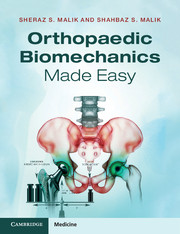Book contents
- Frontmatter
- Dedication
- Contents
- Contributors
- Epigraph
- Preface
- Acknowledgements
- Part I Orthopaedic biomaterials and their properties
- Part II Engineering theory applied to orthopaedics
- 3 Modes of loading in the musculoskeletal system
- 4 Biomechanics of fracture
- 5 Biotribology
- Part III Clinical biomechanics
- Index
- References
5 - Biotribology
from Part II - Engineering theory applied to orthopaedics
Published online by Cambridge University Press: 05 June 2015
- Frontmatter
- Dedication
- Contents
- Contributors
- Epigraph
- Preface
- Acknowledgements
- Part I Orthopaedic biomaterials and their properties
- Part II Engineering theory applied to orthopaedics
- 3 Modes of loading in the musculoskeletal system
- 4 Biomechanics of fracture
- 5 Biotribology
- Part III Clinical biomechanics
- Index
- References
Summary
Introduction to biotribology
A force may change the shape and/or state of motion of an object. The deforming effects of force considered so far have been related to the interactions between force and the entire object and mechanisms that result in the failure of the whole structure. This chapter looks into the deforming effects of force on the surface of an object, which in turn are linked with motion parameters of the object. Therefore, in this chapter, deformation and motion of an object are considered together.
Tribology is the study of the interactions between two solid surfaces in relative motion. It deals with friction, wear and lubrication aspects of the interface formed between the solid surfaces. A force acting at the interface produces friction when the surfaces slide over each other. Excessive friction wastes energy and leads to wear of the surfaces. A lubricant acts to reduce friction and wear by creating a slippery film between the surfaces. The thickness of the lubricant film formed between the surfaces determines the effectiveness of the lubrication.
Different interfaces require a different balance of friction, wear and lubrication. High friction is required between foot and ground for walking and in brakes, whereas low friction is desirable between the components of a car engine. Similarly, wear facilitates brushing teeth and is useful when writing with a pencil, but can also be harmful and lead to the breakdown of mechanical components such as gears. The principles of tribology are used to optimise the performance of interacting surfaces in mechanical systems.
- Type
- Chapter
- Information
- Orthopaedic Biomechanics Made Easy , pp. 80 - 94Publisher: Cambridge University PressPrint publication year: 2015



